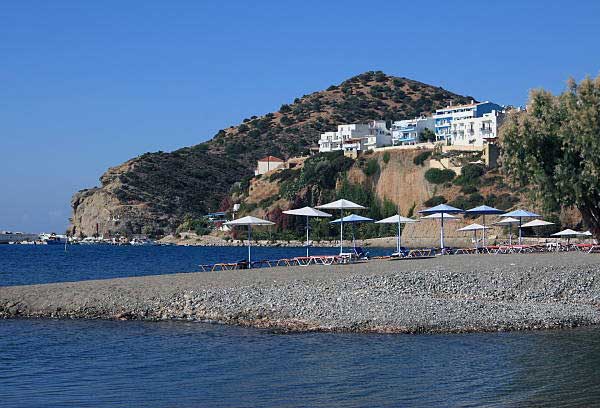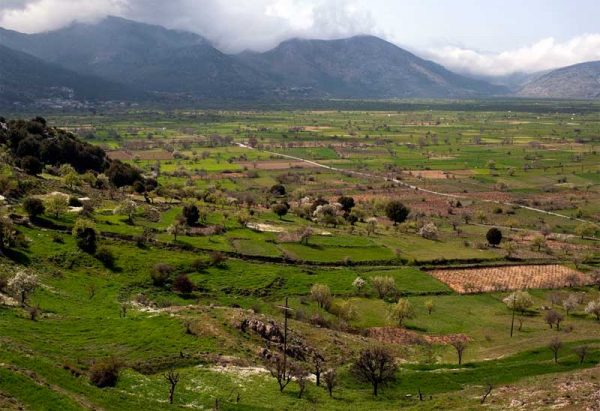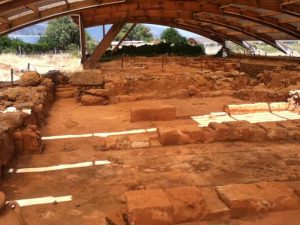Discover the island of Crete Greece

Changing landscape, wonderful seas, mild climate and great sunlight, modern hotel units and a perfect tourist infrastructure, many cultural interests, possibilities for entertainment and sports.
Its historical charm but, above all, its magnificent beaches of fine white sand and the sea with splendid turquoise colors, make it today one of the most desired destinations in the Mediterranean by tourists from all over the world. Crete has been for centuries a proud protagonist of history and mythology, the bearer of a past in which myths and historical reality are founded, with stories of power and death, of supremacy and bitter defeats, never submissive and never weak.
There are monasteries, unspoilt mountain villages, stunning gorges and magnificent scenery enough to satisfy the hardiest hiker and most avid explorer. Despite the arrival of the package holiday industry in force on the island, there are still lovely isolated spots to tempt the independent traveller.
Whatever category you fall into either a self-sufficient backpacker or money-to-burn “can’t last a minute without my laptop” businessman, the highlight of your holiday will undoubtedly be a visit to the breathtaking Minoan Palace of Knossos.
The secrets of the ancient but highly sophisticated Minoan civilisation lay hidden for nearly 3,000 years until a British archaeologist started excavating the palace site in the early 1900s. The treasures uncovered by his team together represent one of the most important archaeological discoveries the world has ever seen. Where else can you see Europe’s oldest throne, still in its original place.
The biggest sceptic and hardest heart couldn’t fail to be moved by this island where myths, legends, recorded history and fairytales have merged into one giant Disney-style world of irresistible fact and fiction. Only on Crete is it possible to visit the reputed birthplace and hideout of Zeus, the king of the gods.
Crete’s ancient history and the extraordinary beauty of the island’s diverse landscape have their own special magic which will cast a spell over you despite the increasing ravages of mass-market tourism.
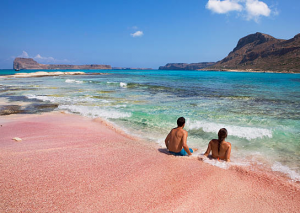
Those looking for a beach holiday will also find plenty to choose from with luxury hotels a firm favourite. Beaches vary from quiet, deserted coves with a single beach cantina to long swathes of golden sand packed with sunbeds and every kind of tourist facility.
In short, holidays in Crete have just about everything for everyone, while the locals have a well justified reputation for friendliness to foreigners.
Crete is one of the most popular holiday destinations in Greece and accounts for a giant slice of the Greek holiday market.
Beaches to the east Crete have long been subject to almost unbridled package holiday tourism with resorts between Heraklion and Malia almost wholly given over to all-inclusive holiday complexes.
Crete in Greek Mytholgy
Cretan mythology has had a significant influence on Greek mythology as a whole, and many of its stories and figures are incorporated into the broader Greek mythological tradition. The most significant key elements and figures from Cretan mythology are the following.
The Birth of Zeus: According to Cretan mythology, Zeus, the king of the gods, was born on the island of Crete. His mother, Rhea, sought to protect him from his father, Cronus, who had a habit of devouring his offspring. Rhea hid Zeus in a cave on Mount Dikte, where he was raised by the nymphs and fed with the milk of the goat Amalthea.
The Minotaur and the Labyrinth: One of the most famous stories from Cretan mythology is the tale of the Minotaur. King Minos of Crete, son of Zeus and Europa, received a white bull from Poseidon as a sign of divine favor. However, Minos failed to sacrifice the bull to Poseidon as he had promised, leading the god to punish him. Poseidon caused Minos’ wife, Pasiphae, to fall in love with the bull, and she eventually gave birth to a half-human, half-bull creature known as the Minotaur. Minos commissioned the construction of a vast labyrinth to house the Minotaur, and it was in this labyrinth that the hero Theseus eventually ventured to slay the monstrous creature.
The Cult of Zeus: Zeus held a prominent position in Cretan mythology and religion. In Crete, he was worshipped as the supreme deity and was associated with many natural phenomena, particularly thunder and lightning. The primary center of his worship was at Knossos, where an impressive temple complex, often referred to as the “Palace of Knossos,” was dedicated to him.
The Goddess Rhea: Rhea, the mother of Zeus, was an important figure in Cretan mythology. She was often depicted as a mother goddess and associated with fertility and motherhood. Rhea was also venerated as a protective deity, particularly in relation to childbirth and the well-being of children.
The Goddess Britomartis: Britomartis was a goddess of hunting and fishing who was particularly revered in Crete. She was often associated with Artemis, the Greek goddess of the hunt, and was believed to have saved herself from the advances of King Minos by jumping off a cliff into the sea, where she was then transformed into a goddess.
The myth of Europa: Europa, the daughter of King Agenor of Phoenicia, was kidnapped by Zeus, who had taken the form of a bull. Zeus carried Europa across the sea to Crete, where she became the queen and mother of Minos, Rhadamanthus, and Sarpedon. Europa is often depicted riding on the back of a bull, symbolizing her association with Zeus and her journey to Crete
Cretan History
Cretan history spans several millennia and is rich with cultural, political, and economic developments.
Crete was home to the ancient Minoan civilization, one of the earliest advanced civilizations in Europe. The Minoans built magnificent palaces, such as the Palace of Knossos, and developed a sophisticated society known for its art, architecture, and maritime trade.
After the decline of the Minoans, Crete fell under the influence of the Mycenaean Greeks and later faced the arrival of the Dorians. The island played a minor role in the wider Greek world during this period.
Crete became part of the Roman Empire in 69 BCE. During Roman rule, the island experienced growth and prosperity. Later, it became part of the Byzantine Empire and played a strategic role in the Eastern Mediterranean.
In the 9th century, Crete was invaded and occupied by Arab forces. However, the Byzantine Empire successfully reclaimed the island in 961 CE after a prolonged struggle.
Crete came under Venetian control after the Fourth Crusade. The Venetians ruled the island for over four centuries, leaving a lasting impact on its architecture, art, and culture.
:
The Ottoman Empire captured Crete in 1669 after a lengthy siege of the city of Candia (now Heraklion). The island remained under Ottoman control until the late 19th century, although it witnessed several uprisings and rebellions during this period.
Crete gained autonomy from the Ottoman Empire in 1898 and later unified with Greece in 1913. The island played a significant role in World War II, experiencing German occupation and participating in the resistance movement. Since then, Crete has been an integral part of modern Greece, known for its natural beauty, tourism, and cultural heritage.
Main towns
Heraklion

A visit to its important Archaeological Museum which houses the largest collection of Minoan art is mandatory. In addition, the Venetian rule of the island bequeathed to the city of Heraklion the Castle of Koules, a majestic building overlooking the port and the nearby Arsenal.
A few kilometers from Heraklion are four of the most important Minoan sites on the island: Knossos, home to the famous palace that housed Minos and the Minotaur, Phaistos, Malia and Agia Triada.
Also very popular are the nearby holiday resorts to the north-east of the city and the splendid beaches of the southern coast such as those near Metala, hidden among the tuff caves.
The city in recent years has been taking on more and more a cosmopolitan aspect: young people flock to trendy clubs, such as the cafes of platia Venizelou, and the famous boutiques. Thanks to its central location, Heraklion offers an excellent starting point for the visitor who wants to discover the beauties of the island of Crete.
Chania
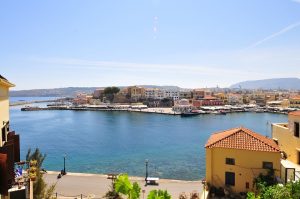
During the Venetian rule the city experienced its maximum splendor, so much so that Chania, is known as the Venice of the East. This historic city was also the Cretan capital until the 70’s.
Chania is home to the most beautiful port on the island of Crete and is the starting point for numerous excursions to the western part of the island.
The city center is very elegant thanks to the beautiful Venetian and Ottoman mansions, the beautiful cathedral in the large square, the church of Agios Nikolaos, the mosque in the old port. There are also wonderful beaches near the center.
Rethymno
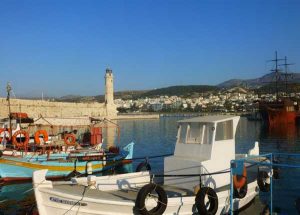
Midway along the north coast, between the two bigger centres of Iraklion and Chania, it is also positioned at one of the island’s narrowest points north/south.
Rethymnon makes an ideal base from which to explore Crete, with south coast beaches are a relatively short drive away.
Rich in tradition and with an extensive town beach there will be those content to stay in Rethymnon and richly rewarded they are, provided they stick to the centre.
The east and west approaches to Rethymnon are a string of hotels and apartments and the south is a twisting uphill battle to the main cross-island highway.
Traffic is heavy and noisy away from the harbour but there is parking space waste land opposite the municipal gardens (except Thursday which is market day.)
The centre is bursting with tavernas and cafes offering good food at decent prices. Apart from the harbour area, where demand for the romantic waterside setting is well reflected in bill, it is a place to eat cheaply and well.
Agios Nikolaos
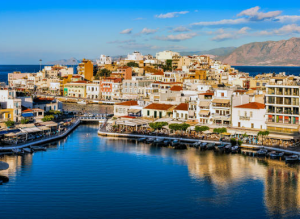
The city boasts a Venetian fortress and which dominates the entire northwestern side of the peaceful Gulf of Mirabello.
A Byzantine church dating from the 7th century AD. C., which offers a breathtaking view of the bay, the Archaeological Museum and the Ethnographic Museum.
Today Agios Nikolaos is a very lively center: tourists are attracted by the blue waters of its gulf, by the nearby unspoiled beaches, by the lively nightlife in pubs and discos and by the large luxury hotels.
The city has many tourist shops where you can buy traditional Cretan items, for example strong raki liquor, textiles, jewelry, and much more. An 18 hole golf course is just 30 minutes away from the center as well as several water parks and a number of important archaeological sites
Cultural attractions
The archaeological site of Knossos and the archaeological site of Heraklion are among the most important institutions in the world and are worth seeing at least once in a lifetime. Festus, Gortyna, Agia Triada and many others make cultural visits interesting and varied. Added to this are historic centers, monuments, churches and monasteries rich in history and charm.
Between beaches, architectural views, natural landscapes… you will need many GB of memory for all the photos you take.
Nature and hiking (hiking, trekking…) – The Cretan section of the European hiking trail E4 is a paradise for hikers and trekkers. The Samaria gorges are the excursion to do absolutely, even if you are not an expert.
Crete is an island where mass tourism dominates. Yet there are many more authentic places to spend relaxing holidays away from the chaos
Direct flights from the UK to two different airports, good tourist facilities, equipped beaches and a plethora of useful services make it possible. Crete is also perfect for holidays with children of all ages, even if you need a type of holiday that is not suitable for children to get around it.
The public service works well even if it is aimed mainly at residents. Crete is so big that it would be impossible to cover it in a capillary way. Better to rent a car and travel in complete autonomy.
The island is really big, so the competition between hotels and restaurants is very high. The prices are very low and if you book in advance, even those of the airplanes.
Nightlife
Malia and Hersonissos guarantee incredible nights of fun. Other locations are organized to do something in the evening. Crete offers endless opportunities for clubbing and nightlife. It is a mistake to think that the heart of the night life of Crete beats only in Malia and the Peninsula. Bars that have nothing to envy the bars of Mykonos or Athens or any other city you will find in all the tourist areas of the island, in Heraklion, Rethymno, Agios Nikolaos and elsewhere
Geography
Due to its geographical position in the heart of the Mediterranean, the island has experienced various dominations that have increased its historical charm.
Endless dreamy beaches, Venetian old towns, castles and palm groves, wild gorges and unique archaeological sites, cosmopolitan resorts and traditional recipes that have never been left in the closet, but climb to the top of their healthiest Mediterranean diet, writers.
The west coast of Crete offers more modern facilities while the south coast still retains the authentic charm of the past. Furthermore, the welcome of the Cretan people is as warm as the Mediterranean climate that characterizes the island.

Quieter, colourful and ideal for on the road excursions on routes with incredible landscape changes in the spring, full of life from thousands of tourists in the north and untouched corners for holidays in the south. Dreamy labyrinths with exquisite architectural samples of Venetian and Turkish rule in the old cities and ports of Chania and Rethymno
Climate

The summer temperatures are classically dry and hot with average temperatures between high 20s to low 30s Celsius but can reach the high 30s to mid 40s and, depending on closeness to the sea, the humidity can be high in summertime.
Winters are usually fairly mild although, in the mountainous regions, snow is common and temperatures can drop to abnormally low levels.
Snow can stay on the tops of the highest mountains for the whole year but it is very rare to have snow in the low lying regions. The southern coast of the island which includes the Mesara Plain and the Asterousia Mountain range falls within the North African climatic zone and consequently has considerably more sun and higher temperatures all year round.
Nature
The Cretan nature is a treasure with thousands of different landscapes that you must discover and that takes time. When it comes to the whole island, the treasures that are revealed are countless and the concept of time begins to lose its essence. Below you will find a list of the most beautiful natural parts of the island.
The highest mountain of Crete has taken root deep in the soul of the Cretans.
Countless local folk songs have been sung about its wild peaks, the rugged Cretans living in its villages, the way of life in the mountain pastures, the genuine Cretan soul that Psiloritis represents. Here, however, the past and the future coincide: in the Idea Cave of Psiloritis, Zeus himself found refuge and was raised, according to mythology.
Economy
Crete as one of the largest exporters of olive oil abroad, its main product is olive oil and olives. In the provinces of Malevizio, Temenou and Pediados, the largest production of grapes in Crete takes place. The main products are sultanas, Malevizi wine and Rozaki grape varieties. The region also produces raisins, fruit and vegetables, citrus fruits and cereals. Bananas in Arvi and Malia, diktamo in areas of Viannos and generally in the foothills of Mount Dikti, such as Embaros. 70% of the wine produced in all of Crete is produced in the valley of Pezo and covers 20% of the wine produced in all of Greece.
Animal husbandry is one of the important economic activities in the hinterland of the prefecture, as there are thousands of goats and sheep, not only for meat but also for the production of authentic cheeses and milk. In the city of Heraklion, a large part of the industry and crafts is concentrated, mainly in food products. It has an industrial area 4 kilometers southeast of the center.
The economic development of the prefecture is significantly strengthened by tourism, where for many years it remains one of the most attractive destinations in the country. The cruise also constituted and constitutes a distinct tourist experience and this can be seen from the rates and numbers that reveal its development, which is characterized as dynamic.
Folk art has been preserved throughout the centuries and today finds its expression in textiles, embroidery, ceramics, woodcarving, metalwork and painting. In all parts of Crete women work at the looms and men at the wheel and bench, offering a wide variety of beautiful works of art.
Beaches in Crete
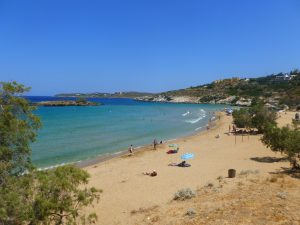
North coast beach resorts vary from the heavily developed holiday resorts like Platanias to the family beach sands of Almyrida and Panormos. Roads thread inland over the mountains passing through traditional hill villages and along dramatic canyons that eventually spill out into the Lybian Sea.
Beaches on the north coast tend to be fairly crowded as they are all linked by the National Road than runs the length of the island. Smallers resorts in areas like Apokoronas, Akrotiri and Kastelli Kissamos offer more relaxed surroundings.
Numerous beaches aligning deckchairs at the bottom of creeks or deserted beaches, white sand or pebble beaches, bathed in turquoise waters, set at the end of pine forests or olive groves, at the foot of mountains or at the mouth of gorges.
Crete offers a beautiful array of seaside landscapes. While the north coast is lined with seaside resorts, the west is home to some of the best beaches. As for the south coast, it features deserted beaches until the heart of summer.

The Cretans themselves are a notoriously proud but extremely friendly, especially with visitors. They have kept their culture, customs and traditions intact despite the annual influx of foreign visitors and right across Crete are charming mountain villages unaffected by tourism.
The island’s remarkable history is evident at every turn, from the extraordinary ruins of the Minoan palace at Knossos to the Venetian Fortezza of Rethymon; the Byzantine mountain monasteries to the simply astounding archaeological museum at Heraklion.
Holidays in Crete
The package holiday industry has well and truly zapped Zeus in terms of being the island’s dominant force these days. Modern hotels, apartment blocks and every imaginable tourist facility have sprung up along the northern coastline to the east of the capital Iraklio.
Much of the eastern area of Crete is now lost to package tourism but the west of the island has the magnificent mountains, the more rugged coastline and the less crowded beaches.
But whichever part of Crete you choose for a holiday there is sure to be a good range of quality Crete hotels to choose from as this is one of the most popular of the Greek holiday islands.
The long summers and the warm, mild winters ensure that Crete holidays attract visitors throughout the year. Those heading inland will find monumental mountains, an abundant archaeological heritage, spirited social history and some spine-tingling scenery.
Those looking for a Greek beach holiday will also find plenty to choose from with luxury hotels a firm favourite. Beaches vary from quiet, deserted coves with a single beach cantina to long swathes of golden sand packed with sunbeds and every kind of tourist facility.
In short, Crete holidays have just about everything for everyone, while the locals have a well justified reputation for friendliness to foreigners.
Culture
In Crete you will find everything you ask for. Traditional color in the unchanged villages of the hinterland for years (Anogia, Askifou, Sfakia, Georgioupolis ), where the sui generis Cretans respectfully maintain their traditions and their characteristic Cretan costume touches.
Cosmopolitanism, luxury and high level services that have nothing to envy from the most beautiful resorts of the Mediterranean (Elounda, Agios Nikolaos, Limenas Hersonissos).
Magnificent beaches that will not be unforgettable, but also awesome beach bars for crazier situations and dynamic nightlife for all tastes.
To get a good first taste of Crete, spend a week with ten days – of course by car – focusing on the most interesting points of each prefecture, which are many and varied.The north coast is serviced by a major highway that that runs the 256 km length of Crete, punctuated by the three cities of Heraklion, Rethymno and Chania each full of history and character.
Where to stay
Crete offers a huge amount and variety of holiday accommodation to suit all tastes and budgets. There’s a plentiful supply of cheap and cheerful pensions, camp sites and youth hostels geared to the needs of budget travellers and backpackers. Masses of mid-range hotels and apartments cater for the hordes of package holidaymakers who descend on the island each summer and you’ll also find a generous helping of top of the range deluxe hotels likely to strain even the healthiest of bank balances.
It’s risky to turn up on spec at any of the main tourist destinations without a reservation in July and August though you may strike lucky if you persevere and are prepared to take whatever’s offered. If you visit outside the most popular months (June to September) you’ll be able to get a discount of 50% or more on high season prices if you hunt around. But expect to pay top rates if you’re visiting at Christmas or Easter. Read more about accommodation in Crete
Hiking in Crete
Crete is home to one of the most beautiful and popular stretches of the European path E4, one of the hiking trails of the European Ramblers Association network: a naturalistic itinerary of over 10,000 km that begins in Tarifa, Spain, and passes through France, Switzerland , Germany, Austria, Hungary, Romania, Bulgaria and Greece, ends in Cyprus.
The Cretan stretch is over 2000 km long and winds through difficult paths practicable by expert hikers and others easier practicable by everyone. It allows you to discover a Crete that is not at all touristy and admire the rich Cretan flora and fauna, visiting unspoiled mountain landscapes, beautiful valleys, archaeological sites and the remains of ancient cities off the classic tourist routes, small traditional villages, bays with amazing deserted beaches. It is often possible to find local guides who organize excursions to discover the island’s animals, flowers and plants.
The most popular nature excursion in Crete is that of the Samaria gorges, which with their 16 km are the second longest canyon in Europe. It is an itinerary in nature that can also be followed by non-experts: it is a unique experience to be in contact with nature and the animals that populate the island.
What to see
Crete is home to wonderful historic towns and traditional villages. The island also boasts important archaeological sites including the majestic Palace of Knossos, home to what was once the great Minoan civilization. There are almost too many interesting sites on Crete to mention. Everywhere is surrounded by beautiful landscapes with the central mountain ranges forming an impressive backdrop. Here are just a few of the top sights to see on Crete.
In addition to the fantastic sea of Balos, Falasarna, Elafonissi and other world famous beaches, Crete really offers everything you want: archaeological sites and (Knossos, Phaistos, Heraklion), museums and art galleries in Heraklion and Chania, entertainment and nightlife in Hersonissos, Malia, places of exotic charm Vai beach,Preveli beach, romance and spectacular sunsets at Loutro and Agia Roumeli, cities of fascinating architecture kike Chania and Rethymno, nature and trekking in Samaria and Kourtaliotis gorge.
Crete is an economic island when compared to the other Greek islands, and even more so than the best known and most popular Italian tourist resorts. The nightlife will not disappoint those who consider the holiday to be fun and summer adventures, just stay in Hersonissos or Malia. Crete also lends itself to quiet and relaxing holidays: couples and families can easily find beaches and small villages free of chaos and crowds. During your stay you come into contact with the people with the islanders, people with a greater cordiality than that which already characterizes the Greeks of the other islands.
Difficult to answer the question: “What is the most beautiful area of Crete?”. Each of its parts offers aspects and characteristics that can more or less adapt to your idea of a holiday. Before organizing a trip to Crete, it is necessary to inquire about the island and know how wonderful it can offer.

Samaria National Park
This breath taking 16km long gorge is one of the longest in Europe and a hike of the complete gorge takes five to seven hours.
In the south the cliffs can claustrophobically close and almost converge at the ‘Iron Gates’ where they are just 4 metres apart at the base and tower 1,000 ft up. The park is open from May to mid-October.
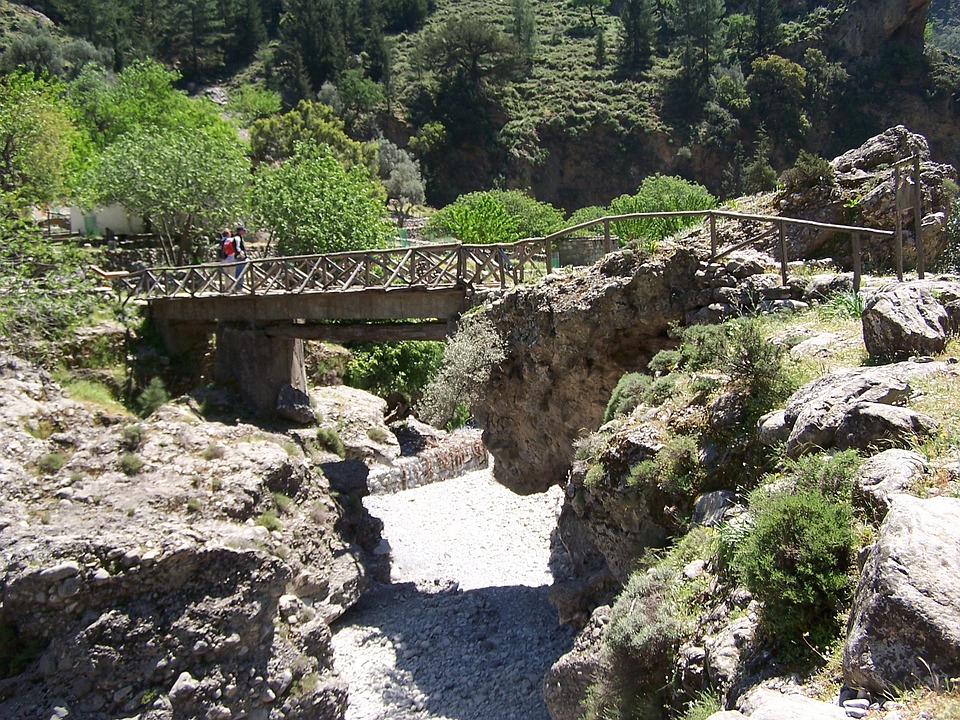
Palace of Knossos
The ruins of ancient Minoan civilisation are by far the most extensive and famous sites on Crete while the Archaeological Museum of Heraklion contains wonderful treasures from the site.
Another interesting Minoan site located at Zakros in the east Crete.
The ruins of Phaistos and the Palace of Malia are also most impressive but remember Crete covered in ancient treasures and interesting ruins can be found almost anywhere. Most sites are well marked with road signs in English and Greek.
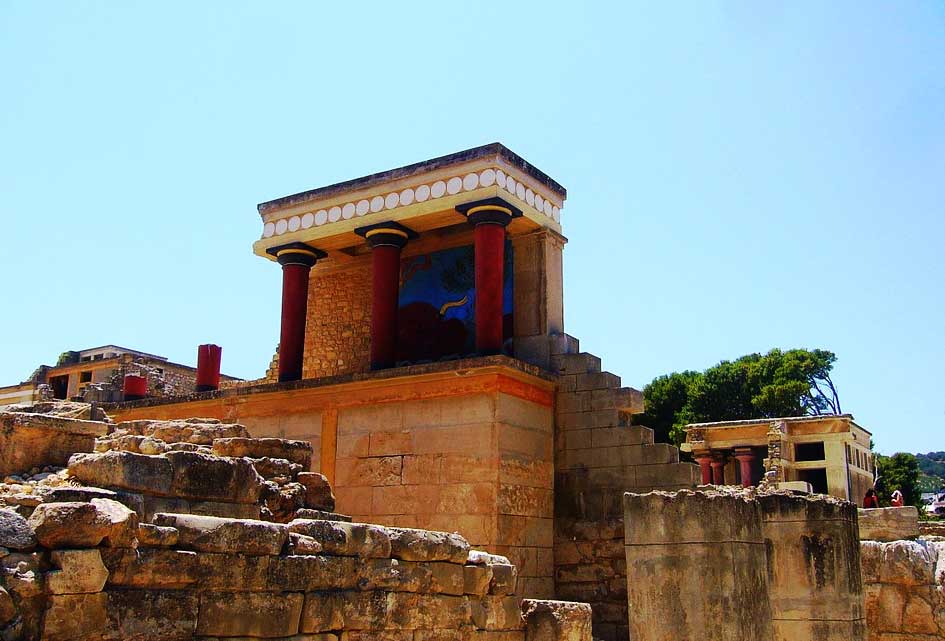
Visit Rethymno
The approaches to Crete’s third largest city of Rethymno, about 60 kilometres from Chania, have a scruffy air of urban sprawl – but what a difference in the heart of the city with its aristocratic air of arched doorways, crumbling balconies and faded facades.
Charming Venetian buildings nestle next to the slender minarets of Turkish mosques and almost every street has an abundance of cafes and restaurants intermingled with craft and antique shops.
The most picturesque part of Rethymnon is the old Venetian harbour where romantic, if pricey, taverna tables line the quay and the Venetian lighthouse stands sentinel on the long harbour wall.
The beach lies to the east, a large flat triangle of palm fringed packed sand backed by hotels, shops and cafes, The water is generally calm and shallow with watersports on offer.
The Fortezza is the jewel in Rethymnon’s crown. The largest fort ever built by the Venetians is an impressive sight and at the main entrance is a good archaeology museum where exhibits include helmets, bronze axes, an extensive coin collection along with many finds from Minoan tombs.
Other notable city sites include the Arimondi fountain, built in 1623, and the slender Nerantzes Djani minaret attached to a former Venetian church and visible from almost anywhere in the city.
Nightlife in Rethymnon is fairly lively and there are plenty of waterfront tavernas for a quiet, romantic meal. By day there are ‘pirate ship’ cruises to see dolphins, caves and offshore islets.
Rethymnon Carnival has three weeks of parades in the run-up to Lent. The Renaissance Festival is in July/August with music and drama while the Wine Festival, in July, has music, dancing and barrels of local wine.
Agia Galini
Agia Galini village is pretty enough, with whitewashed houses perched on the steep streets around an attractive harbour.
All roads lead to a large quayside hedged with flower-bedecked tavernas that could be one of the prettiest spots in the village if it did not double as a drab car park.
The Agia Galini beaches are some way out of the village, around the headland, beneath vertiginous cliffs, and beyond barriers that prevent cars getting through.
It is a 100 metre walk to the first beach of coarse sand and pebble filled with sun loungers. The grey gravel slides sharply into a rocky seashore.
Beyond that, across a small bridge, is a second Agia Galini beach has even coarser sand. There are loads of beach tavernas, indicative of the popularity of the place, as are the premium prices.
Despite an overdose of tourism, Agia Galini is still a resort of some charm with around 1,000 permanent inhabitants and many well-appointed hotels, apartments, camping sites and such.
There are caves along the coast and excursion boats will take visitors there. Some Minoan excavations can be found at Agia Trianda and at Festos out on the road leading north from the resort.
Crete Monasteries
These are found all over the island, most are well signposted and almost all allow visitors and will have a small museum.
Some of the best are Selinari, on the National Road between Malia and Agiios Nikolaos; Prevelli Monastery near Spili which played a huge part in World War II and has one of Crete’s most spectacular beaches nearby and Arkadi which houses the ‘Sanctuary of the Dead’ where rows of ancient skulls line the shelves.
Fragocastello
Fragocastello is located in a remote corner of the Sfakia region in southern Crete. On a plain of wild beauty, with the White Mountains in the background, endless sandy beaches stretch along the Libyan Sea.
This place is one of the many surprises that the nature of southern Crete offers to the visitor. The magical picture is completed by the Kallikratis Gorge with the homonymous plateau and, a little further, the magnificent Imbros Gorge.
Fragocastello takes its name from the famous Venetian fortress that dominates the area, built in the 14th century.
Lasithi Plateau
This large and fertile plateau lies hidden in the mountains in the centre of the White Mountains. It has dozens of old stone windmills, many turned into beautifully restored private homes.
Apples, walnuts, pears, cherries, almonds and plums are grown on the Lasithi Plateau, where excellent quality agricultural products (Lassithian potatoes, vegetables, pulses, grains) are produced and thousands of goats and sheep graze.
The topography of the area is composed of a large flat arable area, dozens of peaks around, small fertile valleys and mountain passes.
The Cedar forest
The Cedar forest (Kedrodasos in Greek), located in Southwest Crete, 1 km from Elafonisi. Huge Cedars with thick shade, turquoise crystal clear waters, and few points with pink sand! Because it has nothing else there except free campers, it would be good to have purchased water and edibles from before.
It is a little congeniality to find it. Path to dirt road between greenhouses, so without good instruction you think you end up in the same place, but not constantly. You should ask for information in Elafonissi long before you get to the beach at the first mini-market.
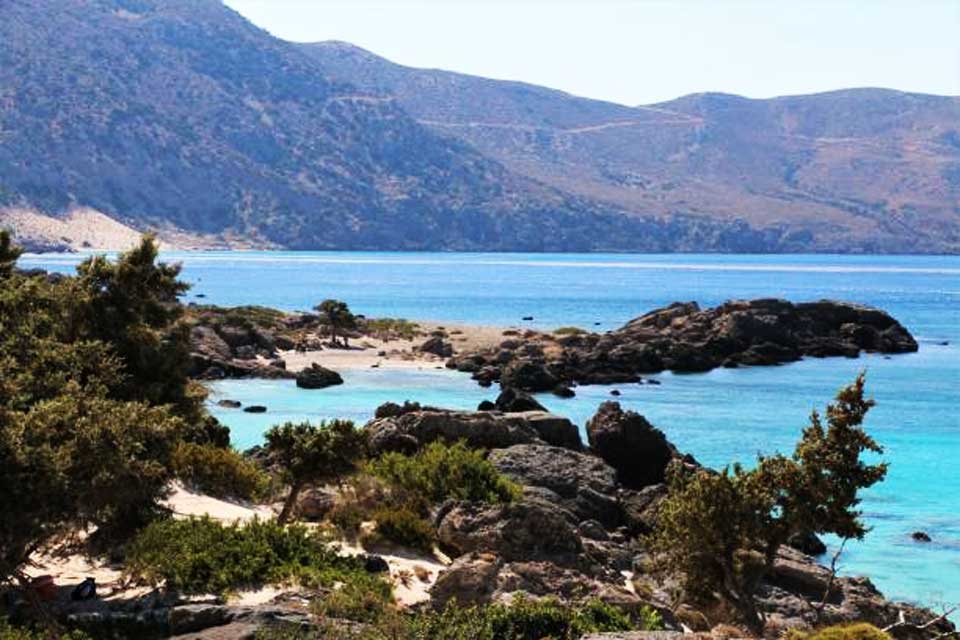
Arkadi
The monastery in Arkadi near Rethymno is worth a visit for its Venetian sculptures and the unique bell tower. It also symbolizes the history of the struggle of Crete for independence. In 1866, more than 1,000 people took refuge here during the island’s uprising against Turkish rule. When the Turks invaded the monastery, gunpowder depots exploded and hundreds of refugees were killed. Those who survived the blast were slaughtered by the Turks and a monument marks the spot where they lost their lives.

The Venetian walls of Heraklion
The mighty 13th century Venetian walls enclose the old port of Heraklion, offering the best view of the small fortified fortress of Koule. Paying more attention to this building you will see the Lion of St. Mark carved in the stone structure, above the main gate. This pattern of Venetian power is found in many monuments in northern Italy and the Eastern Mediterranean.
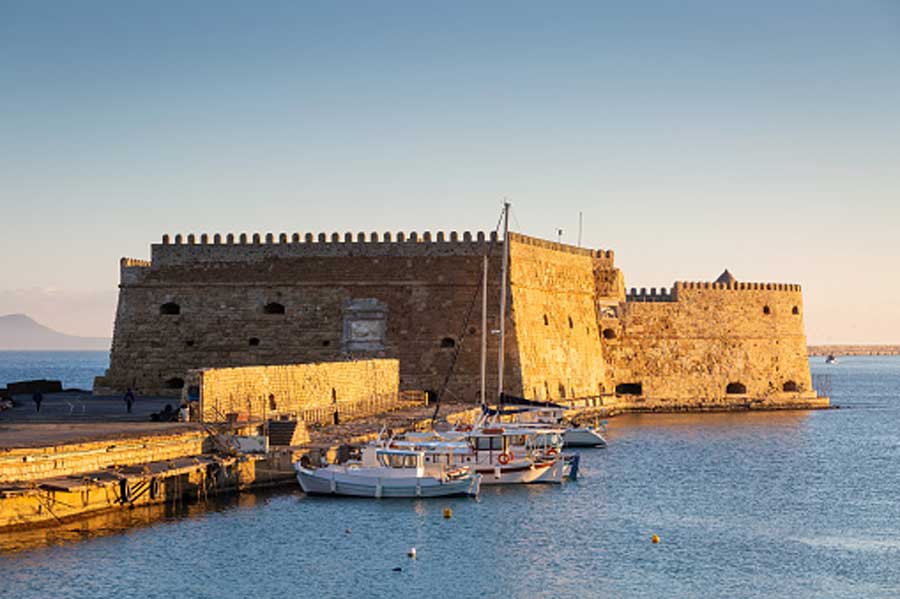
Loutro
The charming seaside village of Loutro can only be reached by boat or on foot. It has remained a pleasant and traditional white village and spending the day there is like a journey through time. It is the biggest secret of Crete, offering swimming, a relaxing meal in a tavern or relaxing moments watching the boats coming from Chora Sfakion. The small fishing village of Loutro nestles picturesquely with its snow-white houses in the small bay on the south coast of Crete! Several taverns and a fine pebble beach invite you to stay. But first you have to get to the picturesque place. Because what is special about Loutro: You can only reach the village on foot via Anopolis (duration: 3 hours) or by ferry from Chora Sfakion! The car-free fishing village is absolutely worth seeing and there are also some family-run guesthouses and hotels in Loutro. Perfect for individual tourists and hikers!
Archaeological site of Aptera
The archaeological site of Aptera, located on a flat hill east of the village of Megala Horafia, was one of the most important ancient cities in northwestern Crete which also developed strong maritime activity.
Rich and interesting archaeological site on a vast territory where the remains of different periods of Crete, among others: Minoan, geometric and Roman tombs, fortified walls, classical and Hellenistic buildings and temples, a theater , cisterns, a villa and Roman baths, early Christian remains, the monastery of Agios Ioannis Theologos, the remains of Venetian ruins, the Turkish fortress of Koules Palekastro and a point exceptional view to the north over the bay of Souda with the fortress of Itzedin and to the south over the foothills of the White Mountains.
The objects discovered during the various excavations are exhibited in the Archaeological Museum of Chania.
The central part of the site is fenced and subject to the purchase of a ticket. The visit remains free of access for certain places such as the fortified walls at the entrance of the ancient city, the Roman villa with peristyle, the installations of the Second World War.

The White mountains
The bare mountain peaks you see as you reach Chania are the highest peaks of the White Mountains, the wildest mountain range in Crete.
They are called by the locals Madares. The White mountains are spread over a huge part of Chania, from Apokoronas to Selino, Sfakia and the borders of Rethymnon. The highest peak is Pachnes (7,800 ft.), Where you can reach following the dirt road from Anopoli Sfakion to about 2,000 m., And continuing from there on foot for two hours about.
Lake Kourna
It is the only natural lake in Crete and that would be enough to make it special. But put the wonderful landscape, between the olive trees and the mountain slopes, also think that you can go boating or cycling in the waters of Lake Kournas or just enjoy moments of relaxation, and you will understand why it is an attraction for locals and foreigners.
It is located at an altitude of 20 m above sea level, its maximum depth reaches about 22 meters and is protected by the Natura 2000 network. It is 43 km from Chania and the road brings you right to its shores.
In Crete, Lake Kournas is famous to the locals for the charm that exudes its eerie beauty. Its waters change colors magically, its aura is strong and a melody seems to come out of the water that captivates those nearby.
Who can resist such beauty? Almost anyone. The flora and fauna of the lake is special, while in its waters one can find eels, rare fish or endemic to Crete, oysters, ducks, water snakes and a rare species of two-colored turtle.
Spinalonga
The barren island of Spinalonga was a colony of lepers until 1957. Today it is uninhabited, but one can visit it by boat from Elounda. The deserted streets of Spinalonga, the old stone houses, the fortifications and the cemetery have an awesome and tragic beauty as they slide slowly into the desert.
Thousands of visitors visit this beautiful island every year with boats departing from Agios Nikolaos, Elounda and Plaka which is located directly opposite the mainland and is about 800 meters away. The history of Spinalonga until 2005 was not particularly well known
The Minoan Palace in Malia
The Minoan palace in Malia may not be as well known as Knossos, but they are certainly quieter, despite the strong reputation of the city of the same name. Here you will find many monuments to explore, such as the ruins of a huge palace complex, with imposing villas, some of which had luxurious bathrooms. All of these are built in olive groves, although the sea view has been lost due to the guards that have been placed around the complex.
Chania Old Town
Chania is the most beautiful city of Crete and its old part is full of synagogues, mosques and churches, as well as magnificent buildings of Turkish and Venetian origin, gathered around the coastal road of the port. You will find modern boutiques, bars and taverns on the waterfront, next to the dome of the Hassan Pasha Mosque and the Venetian Grand Arsenal.
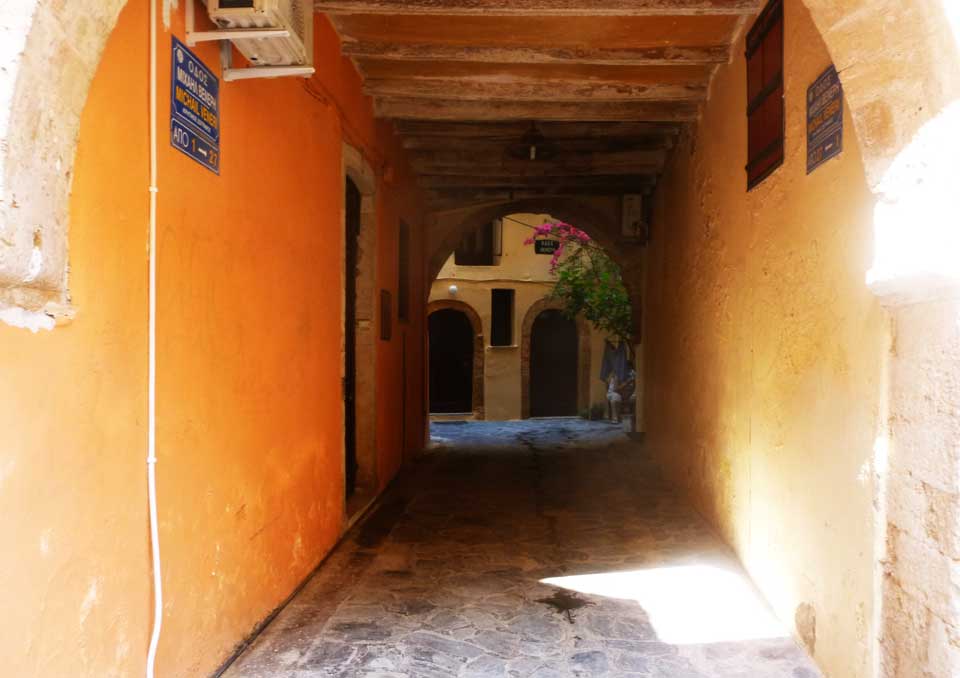
One of the most famous beaches of Crete, Matala, became famous in the 1970s, when hippies landed on the island from all over Europe. It is still a popular destination, but it is no longer so bohemian. The sandy beach offers a backdrop that looks like a honeycomb, with many caves and a relaxed village with plenty of seafood taverns. See the sunset just above the island in the middle of the bay.

Margarites
The small mountain village of Margarites is well known for its handmade pottery workshops, nowhere else will you find so many shops, many of which have been making jugs, cups, vases and bowls for several generations!
When shopping, you should always pay attention to the stamp on the bottom of the pottery, because unfortunately imported products are now also being sold. There is a small kafenio directly on the square of the village, perfect for a break from the tour of the historic village center.
A breathtaking view over the natural landscape and all the way to the coast is offered to visitors during their shopping spree in the pottery village of Margarites.
Gavdos
According to Homer, Gavdos is the island where Calypso held Odysseus captive for seven years. So the island’s fanatics return again and again every summer here, “captives” of its simplicity and beauty. Relaxation, tranquility, endless beaches, rhythms that make you forget the time.
It is located in the southernmost part of Greece, it is scattered with paths and the cedars reach the sea. It was already inhabited in the 3rd millennium BC, it is believed that the Apostle Paul was shipwrecked on its shores, flourished during the Byzantine times, was looted by Saracens and pirates.
For years it has been identified with free camping (rooms for rent are minimal), while nudism is allowed. The permanent residents are few and the island is electrified using solar energy.
The port of the island is located in Karaves. You will find five more settlements: Kastri, where there is an agricultural clinic and school, Sarakiniko, with the main tourist infrastructure of the island, rooms and taverns, Ai-Giannis, Ampelos and Vatsiana. In recent years there are rooms for rent on the beach of Korfos.
Together with neighbouring Gavdopoula, it is a station for migratory birds, as well as a refuge for the endangered species of the Mediterranean seal and the Caretta caretta turtle. Gavdos can be reached from Paleochora, Sougia, Plakias and Chora Sfakion.
Paleochora
The seaside resort of Paleochora has a huge 2km long sweep of fine sharp sand. The beach is deep and edged by shady tamarisk trees and has a few basic beach cantinas and a children’s playground.
The shoreline is shallow but there are underwater rocks to stub the toes. These rocks surface at the western end to create interesting pools and small coves. To the east is a narrow stone and pebble beach, much smaller but with good tavernas nearby.
Paleochora town is a knot of one-way streets built on a square grid. Restaurants, cafes and shops lend a cosmopolitan air that defies the resort’s backwater location.
August is a good month for cultural events including a music festival. It is also a good bet for a late break as summers linger in the south.
Above Paleochora is the restored Venetian fort of Kastel Seleno, built in 1252 and rebuilt 100 years later after Cretan rebels destroyed it. What remains is mostly Turkish, rebuilt in the late 1500s.
The resort is open all winter and a few tourists spend the winter months here. It can be wet and windy but there are many days of warm sunshine. This is a good base too for walkers.
Visit Sougia village
Sougia is a relatively remote and long pebble beach found on the south coast of Crete.
In recent years it has become quite popular but at 1km long the beach rarely feels crowded even on busy summer weekends.
Sougia is located about 75km from Chania over the White Mountains of Lefkas Ori. The remoteness has kept it off the main tourist trail, although it is becoming an increasingly popular weekend retreat for local Cretans.
The road north out of Sougia winds up through the pass at Agia Irini and there are a couple of public buses each day. Most visitors to Sougia beach arrive by boat or come on foot from Paleochora.
Almost completely made up of pebbles, with a sharp drop into the sea, the stones are small, so its not uncomfortable to lie on. There are a few sunbeds and the eastern end is popular with naturists.
There is a small village at Sougia, with plenty of low-key accommodation and some very good tavernas (I counted 10) with menu prices that are well below average for Crete.
Sheltered at the end of a long and deep valley, Sougia is well protected from the northern winds and the beach was recently voted one of the cleanest in Greece.
The resort is also popular with walkers as there are some very good trails, notably to the hill viallge of Lissos and through the dramatic gorge at Agia Irini.
Georgeopoulis
Georgeopoulis is now a firm fixture on the tourist map of Crete, sitting as it does on the end of a 7 kilometre stretch of sand half-way between Rethymnon to the east and Chania to the west.
The island arterial road also runs directly behind the resort giving easy access for those who want to use the resort as a base for exploring this part of the island.
Georgioupolis village centre is a real mish-mash with a square cum car park encircled by tourist shops, rental outfits and cafes. Advert hoardings abound and the place has a shabby atmosphere.
Newly built apartments spread over a wide area of what used to be marshland with tall and striking eucalyptus trees everywhere providing plenty of shade.
The deep beach at Georgioupolis runs in an almost unbroken straight line ands a long causeway runs out from the harbour to an attractive and much photographed chapel.
The harbour is a lot less attractive with the rusting wrecks of several boats and an incongruous full-size tarmac covered soccer pitch behind some dilapidated wire fencing.
The low-lying flat scrubland behind the beach is spattered with modern beach hotels and beach village complexes. The marshy land makes this a haven for mosquito larvae and the insects can be a big nuisance in the high summer.
When to go in Crete
Thanks to its location, Crete has a pleasant climate throughout the year. The tourist season generally kicks off from April, from the Orthodox Easter holidays, to end in mid-October when, little by little, the island is left above all to the islanders and those who have to reach it for business.
From January to March, the climate of Crete is rainy but sunny days offer wonderful views of the snow-capped peaks.
If you have chosen this period for your escape to Crete, you can take the time to visit the important museums of the island, such as the Archaeological Museum of Heraklion, or perhaps the numerous archaeological sites and beautiful churches that enrich the landscape.
In March and April the weather is still unstable, with cool nights and the sea still too cold to swim if not for the fearless, but the flowers cover most of the island giving a beautiful glance.
May and June are perhaps the ideal months to visit Crete: the sea is warm, the days are long and sunny, and tourists are still few.
July and August are the most touristic months: temperatures reach 40 degrees with even higher peaks but the breeze blowing on the beaches makes the temperature more than bearable.
This is also the most expensive period, but there are many hotels and if you have the foresight to book in advance you will get a better price.
The months of September and October are also excellent for exploring Crete: temperatures begin to drop even though still reaching 30 degrees, the sea is still very warm and tourists are fewer.
These months are also ideal for those who, in addition to the sea, want to enjoy the nature of Crete, even if a little burnt for months without rainfall, and indulge in some excursions.
In October and early November you will often find hot days even if the weather becomes a little more unstable.
In December, winter also arrives in Crete, although the temperatures are never unbearable since the daytime highs along the coast are between 10 and 18 degrees while in the hinterland they drop by a few degrees.
Getting there
By Air
Crete has three large airports: Heraklion takes the bulk of package holiday traffic heading for the north-east coat; Chania airport is smaller and takes west Crete traffic, while Sitia caters for domestic flights, mainly from Athens. Holiday charter flights arrive at Heraklion and Chania from many European airports. There are daily flights from Athens and Thessaloniki to Heraklion and Chania and also a daily flights to Rhodes.
By Ferry
Most visitors arrive by charter flight at one of the two major airports of Heraklion, in the east, and Chania to the west.
Holiday charters from the UK and Europe arrive from April to November but there are scheduled services and domestic flights throughout the year.
Regular ferry services run from from Piraeus (Athens) to ports at Heraklion, Chania and Rethymnon but it is a long trip; ferries usually leave in the evening and arrive the following morning. The main ferry firms serving Crete are ANEK Lines, Minoan Lines and Rethymnon Lines.
Roads are good but Crete is a very large island. A major expressway runs the length of the island east/west while roads going north/south are mostly single carriageway and snake over impressive mountains and through dramatic gorges.
Getting around
Roads
The main highway runs the length of Crete following the north coast. It’s not dual carriageway but it is wide, well maintained and well signposted, providing easy access to the north coast beach resorts. Roads over the mountains are generally excellent but the winding roads often mean journey times are longer than expected from reading a map.
KTEL runs regular buses between Rethymno and Chania and there are services to many inland villages. Taxis are common and relatively cheap. Fares are regulated and metered.
The main hiking route on Crete is part of the E4 European Long Distance Path. The E4 trail covers the White Mountains (Lefki Ori), Mount Psiloritis and Mount Dikti. The E4 Path is 320 km long. It starts at Kastelli Kissamos in the north-west and crosses to Kato Zakros in the east.
Prefectures of Crete
Chania Prefecture
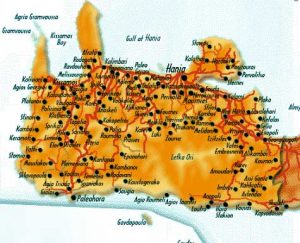
In the peaks, the mountains reach a height of 2,453 m. To the south, the mountains drop bare and steep into the Libyan Sea. The famous gorge of Samaria also runs through the Lefka Ori.
In the northeast of the prefecture of Chania lies the Bay of Suda, It forms the largest natural harbor in Greece. A little further west is the Bay of Chania. Further west is the impressive Bay of Kissamos. All these bays have large beautiful sandy beaches. In the bay of Chania there is also the town of the same name.
Prefecture of Heraklion

According to mythology, Zeus brought Europa, the beautiful princess, here after kidnapping her from the court of the Phoenician king. Minos came from the union of Zeus with Europa.
Heraklion Prefecture is the largest prefecture in Crete. The administration of Crete is located here and most of the sights can be found here.
North of Heraklion is the small island of Dia, which has been declared a wild goat sanctuary. Heraklion has a large artificial port and an international airport that is constantly growing.
Lassithi Prefecture

The prefecture is dotted with beautiful sandy beaches on both the north coast and the south coast. The Lasithi plateau, which gives its name to the prefecture, with its windmills, offers a unique spectacle.
In the Lassithi plateau lies the famous Diktaean Cave. According to mythology, Zeus was born in this cave. At the northeastern tip of the prefecture lies the famous Vai Beach with its palm trees.
Rythymno Prefecture

In this mountain range lies the Idaean Cave, according to mythology, Zeus was raised here. The north coast of Rythimnos prefecture is one large sandy beach.
At the western end of the prefecture’s north coast lies the beautiful town of Rethymno, after which the prefecture takes its name. The capital of Rethymno prefecture has retained much of its old character and charm.
Day trips in Crete
Top of most visitors’ “to do” list is of course the world-famous Palace of Knossos, the legendary home of King Minos who kept the half-man half-bull monster of Greek mythology in an underground labyrinth. The original palace was built around 1900 BC but was rebuilt and restored on several occasions over the next 500 years before it was destroyed in a fire and abandoned.
The ancient Minoan site and all its treasures lay hidden beneath a hill five kilometres south of the island’s capital Iraklio until British archaeologist Arthur Evans started excavations in 1899. He spent the next 35 years uncovering and reconstructing the once magnificent palace which had more than 1,000 rooms, a sophisticated drainage system, elaborate frescoes and a central courtyard where acrobats entertained their royal masters by somersaulting over bulls. Highlights include the en-suite bathroom where the queen bathed in milk and availed herself of a “flushing” toilet (flushed in fact by servants who hand-poured water into the royal loo which was connected to the palace drains).
Allow several hours to explore the site and combine your trip with a visit to the superb Archaeological Museum in Iraklio where you can see a truly outstanding array of finds from Knossos and other Minoan sites on the island.
Just outside Iraklio you can visit the tomb of Nikos Kazantzakis, Crete’s famous literary son who penned many great works including Zorba the Greek immortalised in the film starring Anthony Quinn.
The Palace of Phaistos is another important Minoan site in a spectacular location on a ridge overlooking the south coast of the island. At the nearby ancient city of Gortyna, a Roman capital in AD 67, you can see Europe’s oldest written law code inscribed on a set of stone blocks in the 5th century BC.
If you have time visit the beautiful towns of Rethymno and Hania with their gorgeous harbour fronts and stylish Venetian architecture.
If you’re feeling fit, take a day to hike through spectacular Samaria Gorge, Europe’s longest ravine which is home to an abundance of flora and fauna including the protected Kri-Kri (Cretan wild goat). Allow between five and seven hours for the walk, take water and snacks and wear sturdy shoes.
The stunning mountain-fringed Lasithi Plateau, in the east of the island is well worth a day trip. It’s a vast plain of orchards peppered with no less than 7,000 windmills and a scattering of traditional villages including Psychro from where you can walk to the famous Dikteon Cave, reputedly the birthplace of Greek mythology’s greatest ever god, Zeus.
USEFUL INFORMATION
Useful telephones
- Police 100
- Ambulance 166
- Coast Guard 108
- Forest Fire Center 191
- Fire Department 199
- Tourist police 171
Crete facts
- Size : 8,336 sq km
- Population 650,000
- Season: May – Oct
- Special interest :Museums
- Prefectures:
- Heraklion
- Chania
- Rethymno
- Lasithi
Basics
- Time (GMT) +2 hours
- Power 220v 50AC
- Emergencies call 100
- Top speed 100-120 km/h


